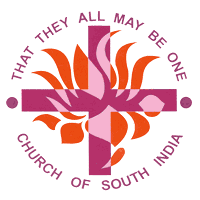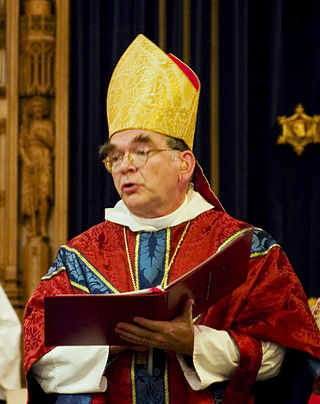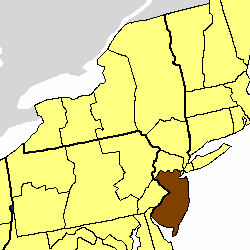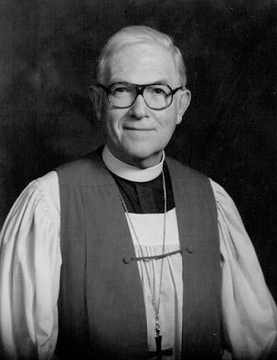
The Church of South India (CSI) is a united Protestant Church in India. It is the result of union of a number of Protestant denominations in South India that occurred after the independence of India.

Robert William Duncan is an American Anglican bishop. He was the first primate and archbishop of the Anglican Church in North America (ACNA) from June 2009 to June 2014. In 1997, he was elected bishop of the Episcopal Diocese of Pittsburgh. In 2008, a majority of the diocesan convention voted to leave the diocese and the Episcopal Church and, in October 2009, named their new church the Anglican Diocese of Pittsburgh. Duncan served as bishop for the new Anglican diocese until 10 September 2016 upon the installation of his successor, Jim Hobby.

The Episcopal Diocese of New York is a diocese of the Episcopal Church in the United States of America, encompassing three New York City boroughs and seven New York state counties. Established in 1785, it is one of the Episcopal Church's original dioceses. The current diocesan bishop is the Rt. Rev. Matthew Heyd, whose seat is at the Cathedral of Saint John the Divine.

The Episcopal Diocese of Georgia, USA is one of 20 dioceses that comprise Province IV of the US Episcopal Church, and is a diocese within the worldwide Anglican Communion. The current bishop is Frank S. Logue, who succeeded Scott Anson Benhase on May 30, 2020, when he was consecrated 11th bishop of Georgia at a service held in Christ Church in Savannah, Georgia.

The Episcopal Diocese of California is an ecclesiastical territory or diocese of the Episcopal Church in the United States of America (ECUSA) in Northern California.

The Anglican Church of South America is the ecclesiastical province of the Anglican Communion that covers six dioceses in the countries of Argentina, Bolivia, Paraguay, Peru, and Uruguay.

The Episcopal Diocese of New Jersey forms part of Province II of the Episcopal Church in the United States of America. It is made up of the southern and central New Jersey counties of Union, Middlesex, Somerset, Hunterdon, Mercer, Monmouth, Ocean, Burlington, Camden, Atlantic, Gloucester, Salem, Cumberland, and Cape May. It is the second oldest of the nine original Dioceses of the Episcopal Church. Services began in 1685 at St. Peter's, Perth Amboy, the oldest parish in the diocese. The diocese itself was founded in 1785.

The Episcopal Diocese of Pittsburgh is a diocese in the Episcopal Church in the United States of America. Geographically, it encompasses 11 counties in Western Pennsylvania. It was formed in 1865 by dividing the Episcopal Diocese of Pennsylvania. The diocesan cathedral is Trinity Cathedral in downtown Pittsburgh. The Rt. Rev. Ketlen A. Solak was consecrated and seated as its current bishop in autumn 2021.
The Oasis can refer to any of a series of diocesan ministries of the Episcopal Church to LGBT persons.
John Palmer Croneberger was an American clergyman of the Episcopal Church in the United States of America. He served as the ninth bishop of the Diocese of Newark.
In the United States, the history of the Episcopal Church has its origins in the Church of England, a church which stresses its continuity with the ancient Western church and claims to maintain apostolic succession. Its close links to the Crown led to its reorganization on an independent basis in the 1780s. In the nineteenth and early twentieth centuries, it was characterized sociologically by a disproportionately large number of high status Americans as well as English immigrants; for example, more than a quarter of all presidents of the United States have been Episcopalians. Although it was not among the leading participants of the abolitionist movement in the early 19th century, by the early 20th century its social engagement had increased to the point that it was an important participant in the Social Gospel movement, though it never provided much support for the Prohibitionist movement. Like other mainline churches in the United States, its membership decreased from the 1960s. This was also a period in which the church took a more open attitude on the role of women and toward homosexuality, while engaging in liturgical revision parallel to that of the Roman Catholic Church in the post Vatican II era.
The Anglican realignment is a movement among some Anglicans to align themselves under new or alternative oversight within or outside the Anglican Communion. This movement is primarily active in parts of the Episcopal Church in the United States and the Anglican Church of Canada. Two of the major events that contributed to the movement were the 2002 decision of the Diocese of New Westminster in Canada to authorise a rite of blessing for same-sex unions, and the nomination of two openly gay priests in 2003 to become bishops. Jeffrey John, an openly gay priest with a long-time partner, was appointed to be the next Bishop of Reading in the Church of England and the General Convention of the Episcopal Church ratified the election of Gene Robinson, an openly gay non-celibate man, as Bishop of New Hampshire. Jeffrey John ultimately declined the appointment due to pressure.

The Anglican Church in North America (ACNA) is a Christian denomination in the Anglican tradition in the United States and Canada. It also includes ten congregations in Mexico, two mission churches in Guatemala, and a missionary diocese in Cuba. Headquartered in Ambridge, Pennsylvania, the church reported 977 congregations and 124,999 members in 2022. The first archbishop of the ACNA was Robert Duncan, who was succeeded by Foley Beach in 2014.

The Episcopal Church (TEC), based in the United States with additional dioceses elsewhere, is a member church of the worldwide Anglican Communion. It is a mainline Protestant denomination and is divided into nine provinces. The presiding bishop of the Episcopal Church is Michael Bruce Curry, the first African American bishop to serve in that position.
The Anglican Diocese of Pittsburgh is a diocese of the Anglican Church in North America. It has parishes in the several counties of Western Pennsylvania. In addition, the diocese has oversight of several parishes that are not located within its geographical boundaries, including three in Illinois, two in Tennessee, and one in Colorado. The diocese also has a parish in Mexico.
The Episcopal/Anglican Province of Alexandria is a province of the Anglican Communion. Its territory was formerly the Diocese of Egypt with North Africa and the Horn of Africa. On 29 June 2020 the diocese was elevated to the status of an ecclesiastical province, and became the forty-first province of the Anglican Communion. The primate and metropolitan of the province is the Archbishop of Alexandria.
The ordination of lesbian, gay, bisexual and/or transgender (LGBT) clergy who are open about their sexuality or gender identity; are sexually active if lesbian, gay, or bisexual; or are in committed same-sex relationships is a debated practice within some contemporary Christian denominations.

Walter Cameron Righter was a bishop in the Episcopal Church in the United States of America. He served the Diocese of Iowa from 1972 to 1988. He then served as assistant bishop for the Diocese of Newark from 1989 to 1991.

Christ Church, also known as Christ Episcopal Church, is a Christian house of worship located on the corner of Church Street and Main Street in Newton, New Jersey. It is a parish overseen by the Episcopal Diocese of Newark, a diocese of the Episcopal Church in the United States of America. The congregation first met on 28 December 1769 and was granted a charter by New Jersey's last Royal Governor William Franklin on behalf of Britain's King George III. Christ Church is the oldest church in Newton and the third oldest parish in the Diocese of Newark.

John Mark Zimmerman is an American Anglican bishop. He was the first diocesan bishop of the Anglican Diocese of the Southwest, which has jurisdiction in west Texas, New Mexico and Mexico in the Anglican Church in North America.

















